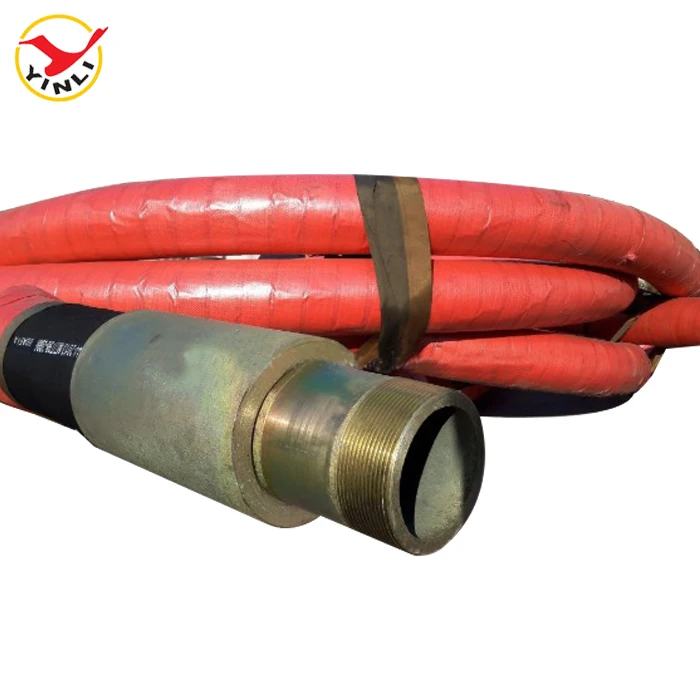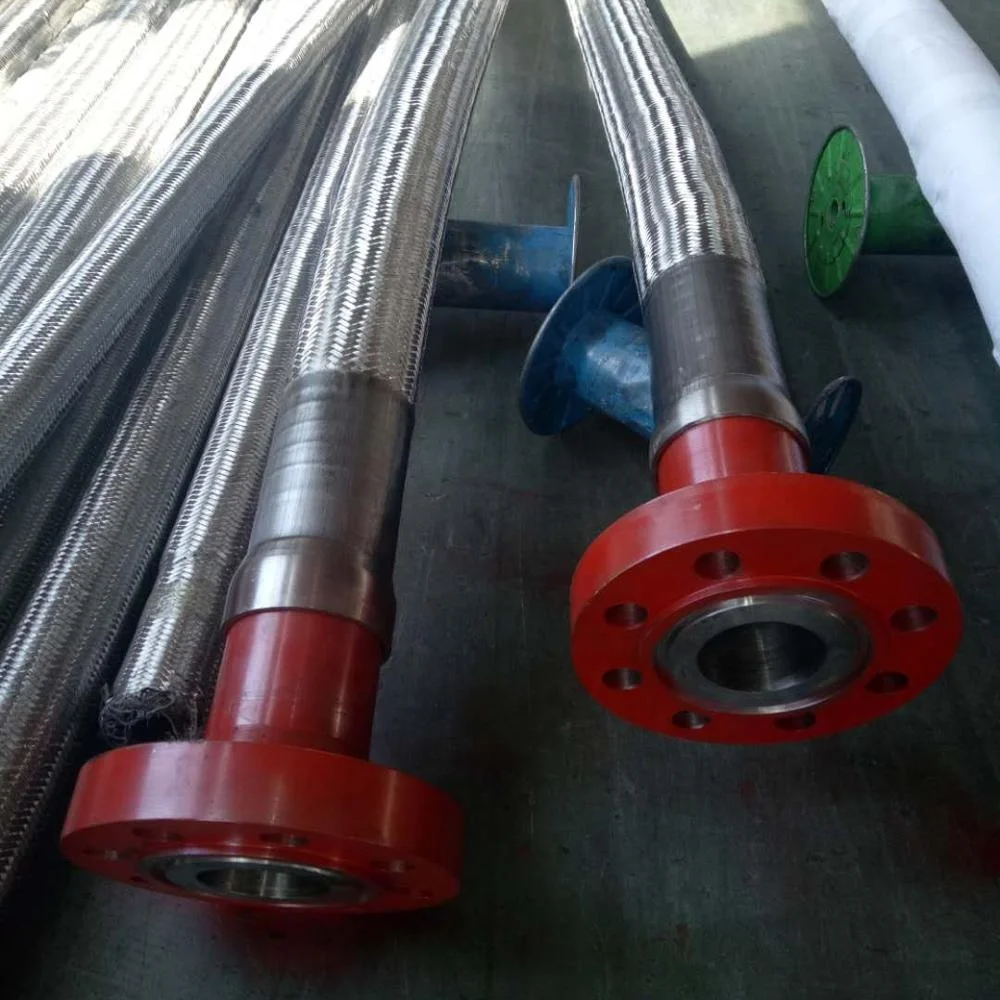kelly hose failer free sample

13 Causes Of Hose Failure 1) Mis-application -Perhaps the greatest cause of failure is using a hose, fitting, or clamp in an application that it is not designed for.
2) Kinking at or near the fittings -Once the barb of the fitting cuts into the tube of the hose, the product being conveyed can escape into the reinforcement and eventually lead to bubbling or blistering of the cover within several feet of the end.
3) Temperature Exposure- As temperature increases pressure ratings decrease. Excessive hot or cold temperatures will lead to discoloration, cracking, or hardness - as well the build up of static electricity if hose wire has not been ground properly.
5) External damage to hose carcass -Kinks, crushed sections, and cover damage which exposes reinforcement will eventually break down the reinforcement and lead to a hose failure.
6) Exceeding the minimum bend radius -Kinking, crushing, or forcing a hose to bend beyond its minimum bend radius (measured from the inside edge of the hose, not the centerline). This is commonly seen on high pressure hoses or vacuum hoses.
7) Defective hose or improperly installed or selected clamp -Failure from a defective hose will typically occur in the first few hours of service, such as pin holes, blow-outs, or tube and cover separation. Improperly installed or selected clamps can result in the coupling ejecting from the end of the hose. Always confirm the manufacturer recommendations based on STAMPED information.
8) Tube or cover not compatible with fluids or environment -Usually results in discoloration, swelling, sponginess, or the breakdown of the hose carcass. For material handling hoses, always rotate to ensure even wear of the hose tube.
9) Old age -Hose is not ‘pipe’, it is a flexible component that will degrade over time. Shelf or service life will range from 1 to 20+ years, depending on its composition, application, and environment. Older hoses become discoloured, stiff, or burst at low pressures.
10) Incorrect hose length -Too short of a length does not allow the hose to expand/contract due to changes in pressure or temperature and causes excessive stress on the fittings or hose reinforcement.
11) Twisting hose during installation or service -Twisting a hose rather than naturally bending the hose will reduce life. It is estimated a 7% twist when installing a hose in a permanent application can reduce hose life by 90%.
12) Poor workmanship -Hose and fittings are made of a unique blend of different materials with complex manufacturing methods - human error, inconsistent machinery, or poor product quality or raw materials can result in defects or variances greater than allowable tolerances. As for failure at the end fitting, ends blowing off assemblies can be a result of sub-standard coupling procedures or due to the “mixing-and-matching” of incompatible hose, couplings, or clamps.
13) Contaminated media being transferred -Foreign particles or residue in the fluid or air can flow through the tube and break it down or wear it out prematurely. Always clean hoses prior to installing in field to ensure there is no cross-contamination.

Flexible drilling rubber hoses play an important role in petroleum extraction. They should suffer high operating pressure, extreme operating temperature, abrasion and other inferior elements. Our special compounded synthetic rubber has been proven an effective and economical way to reject these problems. All our oilfield drill hoses are manufactured as API 7K or other related specifications.
Steel cable reinforcement loads most working pressure up to 15,000psi. The wires are usually zinc-plating or copper platting to improve steel wire resistant against rust and corrosion. Due to the thick reinforcement, the hoses should be handled or stored in correct way to avoid kicking or crushing. They will substantially decrease their rated operating pressure.
Rotary hose, Kelly hose, cement hose, mud hose, jumper hose and vibrator hose and choke & kill hoses are the most popular oilfield rubber hoses. They convey high-pressure drilling fluid from one place to another. Many end fittings are provided to satisfy different applications. Most end fittings are made according to API standards. Special order is also available.

In an ideal drilling environment surface pressure will remain steady and all pressure increases, and decreases will be gradual. This way, when the pulser valve closes(pulses), it’s easily detectable on surface by computers. Unfortunately drilling environments are rarely perfect and there are many things that can emulate a pulse thus causing poor or inaccurate data delivery to surface. The unfortunate circumstance of this means drilling operations must come to halt until data can once again be decoded on surface. This pause in the drilling process is commonly referred to at NPT or non-productive time. For those of you unfamiliar these concepts, I’ll explain some of the basics.
Depending on if the drilling fluid is being circulated in closed or open loop, it will be drawn from a tank or a plastic lined reservoir by a series(or one) mud pumps and channeled into the stand pipe, which runs up the derrick to the Kelly-hose, through the saver sub and down the drill-pipe(drill-string). Through the filter screen past an agitator or exciter, around the MWD tool, through a mud motor and out of the nozzles in the bit. At this point the fluid begins it’s journey back to the drilling rig through the annulus, past the BOP then out of the flow line and either over the shale shakers and/or back in the fluid reservoir.
Suction screens on intake hoses will occasionally be too large, fail or become unfastened thus allowing large debris in the mud system. Depending on the size of debris and a little bit of luck it can end up in an area that will inhibit flow, circumstantially resulting in a sudden fluctuation of pressure.
Over time mud pump components wear to the point failure. Pump pistons(swabs), liners, valves and valve seats are all necessary components for generating stable pressure. These are the moving parts on the fluid side of the pump and the most frequent point of failure. Another possible culprit but less common is an inadequately charged pulsation dampener. Deteriorating rubber hoses anywhere in the fluid path, from the mud pump to the saver sub, such as a kelly-hose, can cause an occasional pressure oscillation.

She notes that while Waugh’s information about books being pulled from curriculum is correct, those books were returned to teachers for classroom use.
The Irving Schools Foundation provided a grant for this new curriculum to purchase six graphic novels. Those included Laurie Halse Anderson’s Speak, Walter Dean Myers’s Monster, John Lewis’s March, Marc Andreyko’s Love Is Love, Cory Doctorow’s In Real Life, and Loic Dauvillier,Greg Salsedo, andMarc Lizano’s Hidden.
“We purposefully chose books on topics our freshman students could relate to — bullying, sexual abuse, child labor, violence, the prison industrial complex and bigotry — because circulation date demonstrated that students were checking out three graphic novels to every five fiction books. We planned to have students self-select two from the set,” said Waugh. She added that the project had overwhelming support from the principal, who’d suggested to her and fellow teacher and project coordinator Carol Revelle to seek funding from the foundation. The principal also attended the grant presentation.
Waugh desperately wishes to see Love Is Loveadded back into the curriculum. Of the six texts, it was the only one to be pulled and only one to not be allowed for classroom use. She’s remorseful for not pushing harder when the book was initially challenged. Though the book has no professional reviews, she noted that other books used in the curriculum lack those reviews as well. Further, it’s often difficult for comics to be reviewed in the same way novels and nonfiction are.

In an effort to help those in the industry adopt a safety first mindset, Grainger, a supplier of MRO products to the oil and gas industry, offers the following guidelines:

This warranty does not cover engine/transmission replacement, internal repairs, differentials, tires or batteries. Separate warranties are available for those products at the Tire & Service Network outlet where the original repair was performed.
![]()
Rotary drilling hose is mainly used for conveying water-based or oil-based mud and other fluids in the working temperature of -30 °C to +82 °C. It is often used for oil fields, cement repairing, geological exploration and water conveyance for coal excavation. It is composed of three parts: tube, reinforcement and cover. The tube is made from NBR, which is resistant to abrasion, corrosion and oils. The reinforcement is made from 2-8 layers of high tensile and high strength spiraled steel wire, making the hose have solid structure and resistant to high pressure. The cover is made from high quality synthetic rubber, mainly chloroprene rubber, making the hose resistant to abrasion, corrosion, cut, weather, ozone, aging and sunlight. The hose has longer service life as a result.
Dongying ROBUST offers every type and style of rotary drilling rubber hose. Compare the various drilling and hydraulic fracking benefits to determine the best choice for your application.
MAIN APPLICATION:The rotary/drilling hose is used in oil drilling industry, bore hole operation and washing, used on drilling rig for deliveringpetroleum based fluid: water,cement, mud




 8613371530291
8613371530291